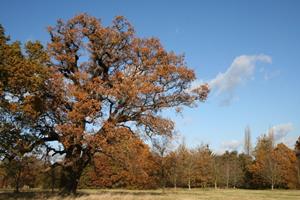Scientists aiming to save iconic British oak from killer disease
Release Date 10 March 2016

It provided the raw materials for Nelson's fleet and the roof of Westminster Hall, and is the symbol of the National Trust - but now the oak tree is at risk of falling prey to a range of new threats.
As one of the most common tree species in Britain, oak is a natural icon, supports a huge array of native wildlife and is worth millions to the economy. Yet oak is facing a barrage of new threats from pests and diseases, many of which are still poorly understood.
Now scientists are fighting back with a £1million research project to prevent the spread of new diseases, including acute oak decline (AOD), a bacterial infection which has spread into Britain and can kill trees within five years of symptoms first arising. There is currently no known cure.
The project announced today (Thursday 10 March) is led by the University of Reading and will harness world-leading British expertise in microbiology, climate science, forestry, and social science to find answers to the growing problem of AOD, as well as exploring the experience of people and institutions responding to tree health issues. The project, called Purpose, also includes researchers from the universities of Oxford and York, the Centre for Ecology and Hydrology, Forest Research, and the James Hutton Institute.
'Doing nothing could put oaks in serious risk of a Dutch Elm-type decline, but with the potential for an even bigger impact on the British countryside' -- Dr Rob Jackson
Lead researcher Dr Rob Jackson, a microbiologist at the University of Reading, said: "We are justifiably proud of the mighty oak, which is a worthy symbol of Britain.
"Yet climate change and globalisation has brought an array of new threats, including bacteria and insect pests, which are conspiring to attack our oak trees. Doing nothing could put oaks in serious risk of a Dutch Elm-type decline, but with the potential for an even bigger impact on the British countryside.
"We believe our innovative new approach could provide a blueprint for future scientific efforts to manage the health of Britain's trees, and could prove useful to managing threats to other species such as ash dieback."
Rather than focusing on just one route to solve the problem, the project will look at a range of options to save the oak, including mapping likely future hotspots, charting the progress of a range of new pests and diseases, as well as finding cures for the AOD infection itself and influencing how institutions respond to outbreaks.
The project has been funded through the third phase of the Tree Health and Plant Biosecurity Initiative, funded under the auspices of the Living With Environmental Change Partnership with support from the Biotechnology and Biological Sciences Research Council, Department for Environment, Food and Rural Affairs, Economic and Social Research Council, Forestry Commission, Natural Environment Research Council and the Scottish Government.